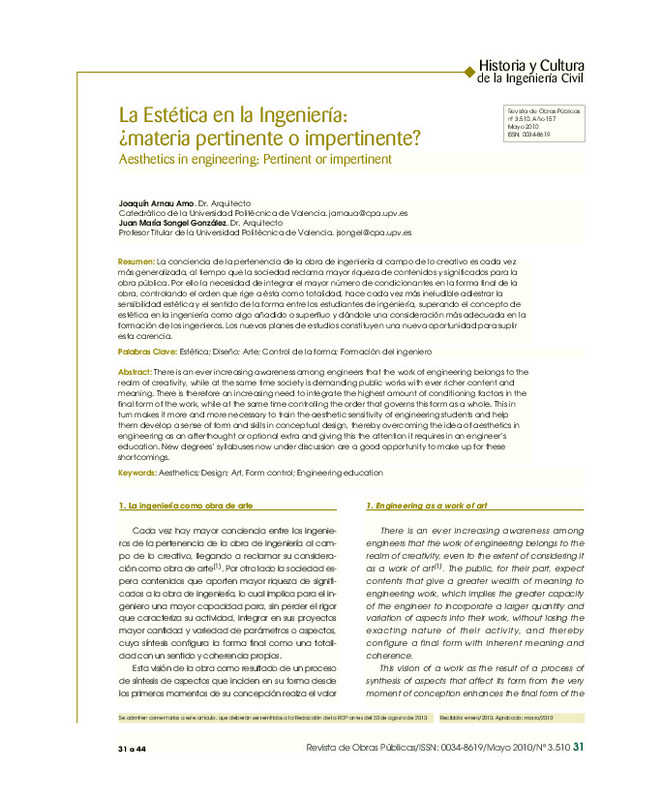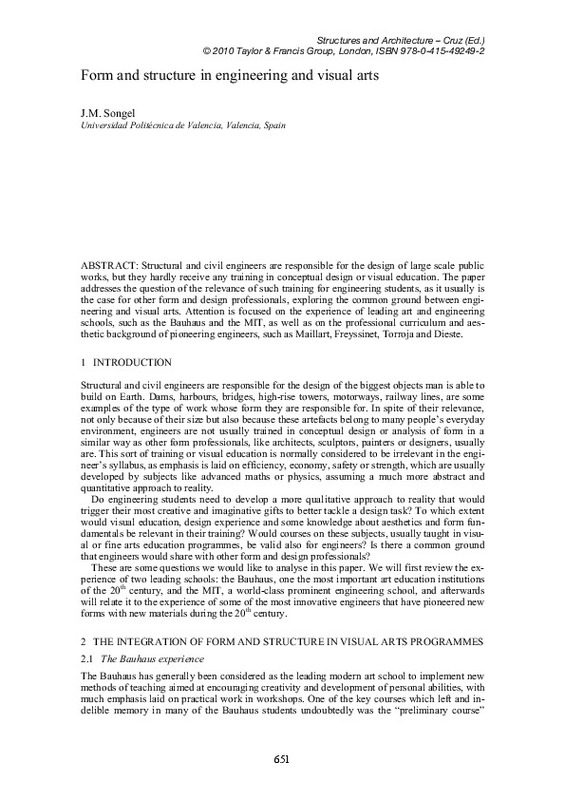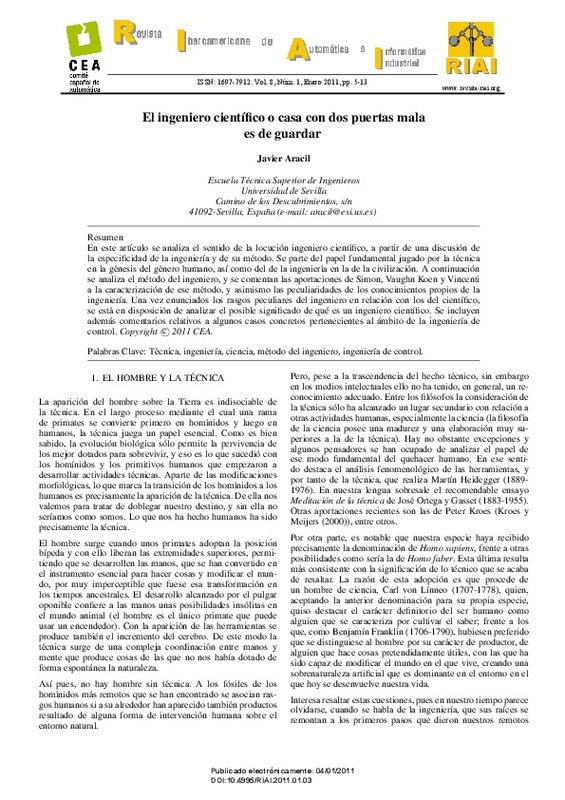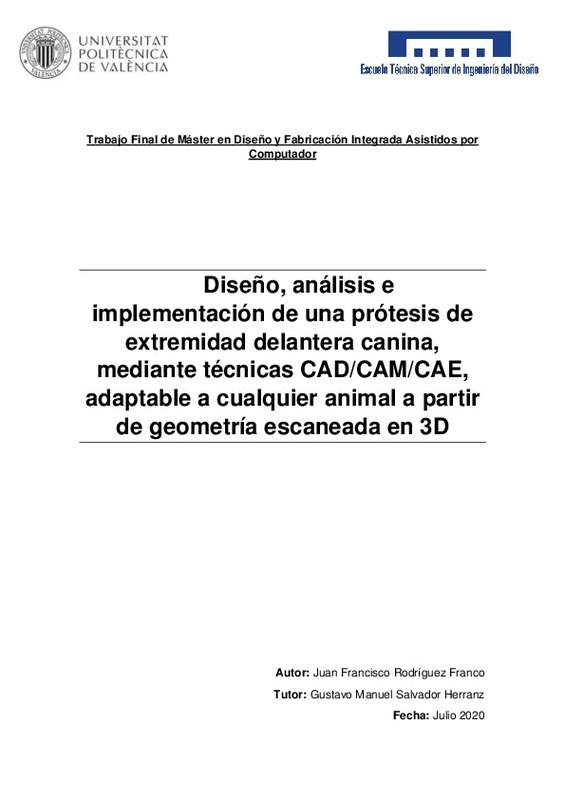JavaScript is disabled for your browser. Some features of this site may not work without it.
Buscar en RiuNet
Listar
Mi cuenta
Estadísticas
Ayuda RiuNet
Admin. UPV
La Estetica en la Ingeniería: ¿materia pertinente o impertinente?
Mostrar el registro sencillo del ítem
Ficheros en el ítem
| dc.contributor.author | Arnau Amo, Joaquín
|
es_ES |
| dc.contributor.author | Songel Gonzalez, Juan María
|
es_ES |
| dc.date.accessioned | 2010-11-10T08:49:39Z | |
| dc.date.available | 2010-11-10T08:49:39Z | |
| dc.date.issued | 2010-05 | |
| dc.identifier.issn | 0034-8619 | |
| dc.identifier.uri | http://hdl.handle.net/10251/8892 | |
| dc.description.abstract | [ES La conciencia de la pertenencia de la obra de ingeniería al campo de lo creativo es cada vez más generalizada, al tiempo que la sociedad reclama mayor riqueza de contenidos y significados para la obra pública. Por ello la necesidad de integrar el mayor número de condicionantes en la forma final de la obra, controlando el orden que rige a ésta como totalidad, hace cada vez más ineludible adiestrar la sensibilidad estética y el sentido de la forma entre los estudiantes de ingeniería, superando el concepto de estética en la ingeniería como algo añadido o superfluo y dándole una consideración más adecuada en la formación de los ingenieros. Los nuevos planes de estudios constituyen una nueva oportunidad para suplir esta carencia. | es_ES |
| dc.description.abstract | [EN] There is an ever increasing awareness among engineers that the work of engineering belongs to the realm of creativity, while at the same time society is demanding public works with ever richer content and meaning. There is therefore an increasing need to integrate the highest amount of conditioning factors in the final form of the work, while at the same time controlling the order that governs this form as a whole. This in turn makes it more and more necessary to train the aesthetic sensitivity of engineering students and help them develop a sense of form and skills in conceptual design, thereby overcoming the idea of aesthetics in engineering as an afterthought or optional extra and giving this the attention it requires in an engineer¿s education. New degrees¿ syllabuses now under discussion are a good opportunity to make up for these shortcomings. | es_ES |
| dc.language | Español | es_ES |
| dc.publisher | Colegio de Ingenieros de Caminos, Canales y Puertos | es_ES |
| dc.relation.ispartof | Revista de Obras Públicas | |
| dc.rights | Reserva de todos los derechos | es_ES |
| dc.subject | Estética de la ingeniería | es_ES |
| dc.subject | Diseño en ingeniería | es_ES |
| dc.subject | Forma en ingeniería | es_ES |
| dc.subject | Arte e ingeniería | es_ES |
| dc.subject | Formación del ingeniero | es_ES |
| dc.subject | Ingeniería civil | es_ES |
| dc.subject | Aesthetics in engineering | es_ES |
| dc.subject | Civil engineering | es_ES |
| dc.subject | Design in engineering | es_ES |
| dc.subject | Education of engineers | es_ES |
| dc.subject | Form in engineering | es_ES |
| dc.subject | Art and engineering | es_ES |
| dc.subject | Visual education | es_ES |
| dc.subject | Structural form | es_ES |
| dc.title | La Estetica en la Ingeniería: ¿materia pertinente o impertinente? | es_ES |
| dc.title.alternative | Aesthetics in engineering: Pertinent or impertinent | es_ES |
| dc.type | Artículo | es_ES |
| dc.rights.accessRights | Abierto | es_ES |
| dc.contributor.affiliation | Universitat Politècnica de València. Departamento de Composición Arquitectónica - Departament de Composició Arquitectònica | |
| dc.description.bibliographicCitation | Arnau Amo, J.; Songel Gonzalez, JM. (2010). La Estetica en la Ingeniería: ¿materia pertinente o impertinente?. Revista de Obras Públicas. http://hdl.handle.net/10251/8892 | es_ES |









